Home → Fish & Wildlife → Wildlife → Species Information → Birds → Songbirds → Purple Martin Landlords
Purple Martin Landlords
We're looking for the next generation of bird conservationists to secure the future of purple martins in Maine.
 Purple martins are the largest member of the swallow family and the only species of martin in North America. They are known for their dark purple-blue iridescence, aerial agility, long migrations, colonial nesting behavior, and human-dependence.
Purple martins are the largest member of the swallow family and the only species of martin in North America. They are known for their dark purple-blue iridescence, aerial agility, long migrations, colonial nesting behavior, and human-dependence.
A purple martin landlord is someone who installs and maintains nesting structures for purple martins, a rare Species of Special Concern in Maine. Providing housing for martins is a proven and relatively easy way for you to take conservation action in your own backyard, and an excellent opportunity for students, birders, landowners, and conservation organizations to team up and secure the future of a beautiful and beneficial bird. Ask any purple martin landlord, and they'll tell you that martins are their favorite herald of spring, they couldn't ask for more active, engaging, and enjoyable neighbors to have throughout the summer months.
Why Purple Martins Need Your Help
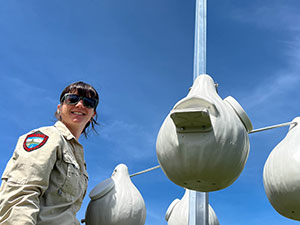 In 1908, "The Birds of Maine" by Ora Willis Knight listed purple martins in "nearly every section of the state", but by the 1980s they began to disappear. As of 2024, Maine has only 9 active purple martin colonies, representing a drastic 95% decline in the last 50 years. Other avian aerial insectivores are also experiencing significant declines, including chimney swifts, cliff swallows, bank swallows, eastern whip-poor-wills, and common nighthawks.
In 1908, "The Birds of Maine" by Ora Willis Knight listed purple martins in "nearly every section of the state", but by the 1980s they began to disappear. As of 2024, Maine has only 9 active purple martin colonies, representing a drastic 95% decline in the last 50 years. Other avian aerial insectivores are also experiencing significant declines, including chimney swifts, cliff swallows, bank swallows, eastern whip-poor-wills, and common nighthawks.
Purple martins have been managed by humans longer than any other species of bird in North America. They are cavity nesters that historically used natural rock crevices or cavities in dead trees created by woodpeckers. Though it is not known exactly why, it is believed that southeastern Native American tribes began providing hollowed-out gourds for purple martins hundreds or even thousands of years ago.
Combined with a decline in natural cavities, the long-term provision of martin houses led to a shift toward preference for dwellings in close proximity to humans. Purple martin populations east of the Rocky Mountains now rely almost exclusively on human-made housing for the nesting season. Without continued support from people, purple martins could disappear from our state altogether. With the current generation of purple martin landlords getting older, it's time for a new generation to take the lead.
Becoming a Purple Martin Landlord
Where to Set up a Nesting Structure
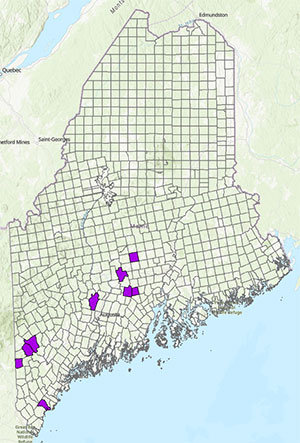
It is currently unknown how far purple martins will travel to establish new colonies. While any location with suitable habitat is worth a try, housing established in or near towns with existing colonies are likely to have the most luck.
Based on data from the 2018-2022 Maine Bird Atlas, those living in or near Corinna, Belgrade, Kennebunk, Thorndike, Unity, Porter, Denmark, Pittsfield, or Frenchboro are in an excellent position to help facilitate expansion of the distribution and abundance of the species.
Choose a location on land that you have permission to access to set up and maintain a structure. Consider setting up on your own property, working with another landowner, or partnering with a local school, park, or land trust. In cooperation with the Bureau Parks and Lands, MDIFW is providing nest structures on public lands including several wildlife management areas.
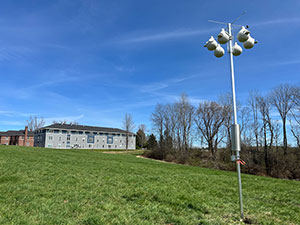
Purple martins are aerial insectivores, meaning they capture and eat insects during flight, or "on the wing." They feed on flying ants, bees, wasps, flies, midges, beetles, butterflies, moths, mayflies, and dragonflies. To find enough food, they need open areas with abundant insects such as fields, farms, ponds, rivers, lakes, bays, or swamps, and will travel 1-2 miles from their nesting site to forage.
The ideal placement of a purple martin nesting structure is in an open area with suitable foraging habitat at least 40 feet from the tallest tree and within 30-120 feet from human housing.
How to Provide Housing
Some purple martin landlords choose to purchase and assemble housing kits while others opt to build their own nesting structures to reduce cost. There are several effective designs but each has a few key elements:
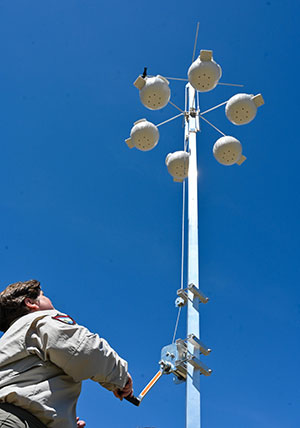
Cavities: Purple martins are colonial cavity nesters. Each cavity accommodates one pair of martins. A minimum of four cavities, and the ability to add more, is recommended to start a colony. Cavities may be provided in a multi-compartment house, natural gourds, human-made gourds, or a combination. There should be a way to open and close cavities as needed to prevent occupancy by non-native and invasive competitors such as house sparrows and European starlings. Perches should also be available for martins to rest, preen, and keep watch for predators.
Pole: The recommended pole height is 12 to 18 feet. The pole should be securely set in the ground with concrete and should have a predator guard to deter raccoons, snakes, and other wildlife from reaching the nesting cavities.
Access: Monitoring, maintenance, and assembly are all made easier when the housing can be accessed by being lowered and raised with a winch, pulley, or telescoping pole.
Whether you buy a kit or build your own, the Purple Martin Conservation Association is a one-stop shop to answer all of your questions about structure materials, sizes, and shapes that attract martins, discourage non-native competitors, reduce predation, protect residents from the elements, and are easy to manage. They also provide a wealth of information to support new purple martin landlords, including tools for tracking migration, attracting martins to a new site, and guidance for colony management. They provide supplies, plans, and even provide mentors!
When to Prepare for Purple Martins Arrival
In the fall, purple martins migrate over 7,000 miles to overwinter in South America. They make the long journey back to Maine each spring, beginning with adults, and followed 4-12 weeks later by younger birds. The first adults to arrive are referred to as scouts and typically return to the same colony where they successfully nested the prior summer.
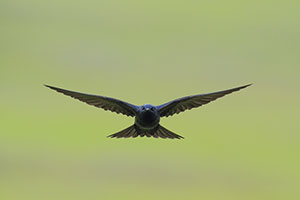
You'll want to have a nest structure set up and ready to go before martins arrive, but not so soon that other species such as sparrows and starlings could claim the nesting site. In Maine, that means having your structure ready to go by mid-April, but keeping cavities closed until the first birds arrive. The Purple Martin Conservation Association shares ongoing results from their scout-arrival study with the public so you can follow along with spring migration and find out when to expect purple martins in your area each season. Purple martin landlords are encouraged to submit their scout arrival dates to contribute to the study.
Taking the Next Step for Purple Martin Conservation
Becoming a purple martin landlord in Maine opens up several opportunities to be involved in research as a community scientist. People who successfully manage colonies have direct access to data that helps biologists understand purple martin migration, diet, habitat, and factors contributing to declines. Purple martin landlords are in a position not only to help a single colony, but to inform recovery efforts for the entire species. If you are interested in taking the next step for purple martin conservation, take a look at these current community science projects:
- Pooper Snoopers is a community science project led by Dr. Anna Forsman at Colby College right here in Maine, in collaboration with the Purple Martin Conservation Association. Purple martin landlords can help investigate diet composition of purple martins in their breeding range by submitting fecal samples from their colony for DNA testing.
- The Scout-Arrival Study tracks the spring migration progress of purple martins by documenting the dates that purple martin landlords report scouts returning to their colony each spring.
- Project MartinWatch is a community science project designed both to help landlords better manage their colonies and help biologists learn more about factors that affect martin nesting success
Not a Purple Martin Landlord? You Can Still Participate in Aerial Insectivore Conservation!
- Delay mowing. If you have open habitat on your property, keep it open! Wait until August or September to avoid disturbing nesting birds.
- Create pollinator habitat. Choose native plants for your garden and minimize reliance on pesticides.
- Participate in a nest box program. The Maine Natural History Observatory monitors tree swallows, eastern bluebirds, cliff swallows, and more.